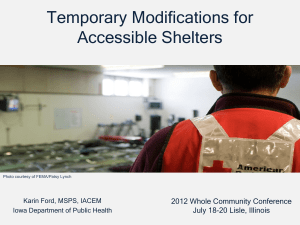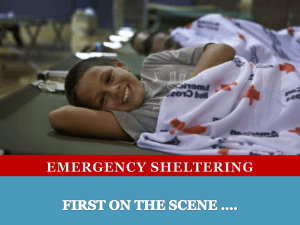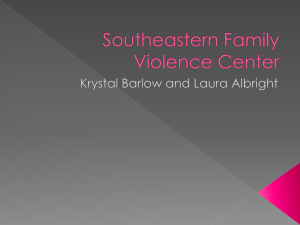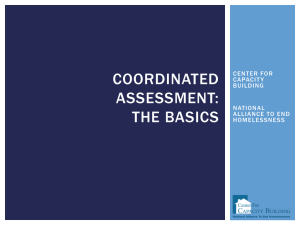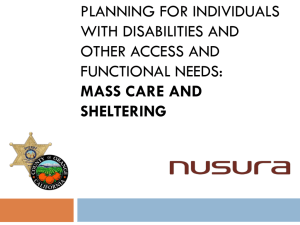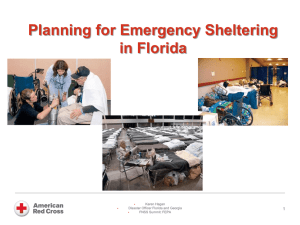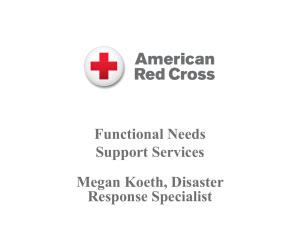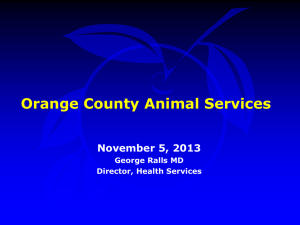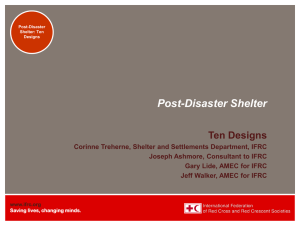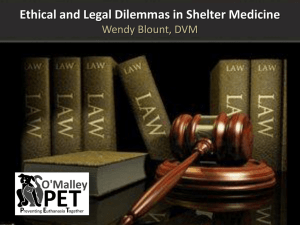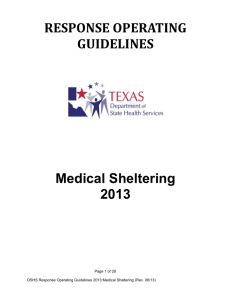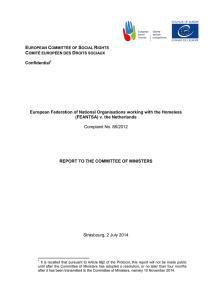One Voice - Rockefeller Center
advertisement
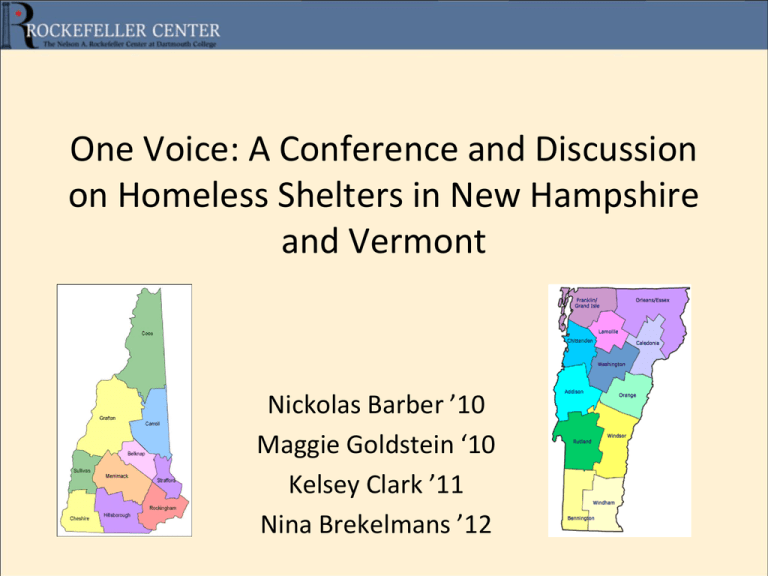
One Voice: A Conference and Discussion on Homeless Shelters in New Hampshire and Vermont Nickolas Barber ’10 Maggie Goldstein ‘10 Kelsey Clark ’11 Nina Brekelmans ’12 Session 1 1. Overview 2. Introductions 3. Summary of findings – – – – – – – – – – – Services Intake Occupancy Facilities Staff Partnerships Rules Finances Strengths Areas of Improvement Success Measurement Conference Overview • • • • Ground rules Expectations Confidentiality Purpose Introductions • PRS Staff • Shelter Directors • State Participants 1.Name 2.Shelter affiliation 3.What you are hoping to take away from today? Data and Research Methods • How it started • Research • Analysis • The Interview – – – – – – – – – – – Services Intake Occupancy Facilities Staff Partnerships Rules Finances Strengths Areas of Improvement Success Measurement The Shelters • Identifying shelters • Shelter demographics – – – – Size Type Location Population served Upper Valley Haven Shelter Services Services (cont.) • Most common – Case Management – Meals – Life Skills; nutrition, time management, cooking, etc. • Least common – Youth programming – Financial Assistance – GED classes • Innovative and Effective – Prevention – Aftercare Intake • Selectivity varies – Everyone admitted – “Hand-selecting” guests who are appropriate for the program • Contracts and agreements upon entry • Intake forms Occupancy Facilities John Graham Shelter • Privacy • Individuals vs. Families • Shelter specific facilities • Community facilities: soup kitchen, food shelf, clothes pantry Staff Full Time Staff • • • • Full-time Part-time Volunteers Board of Directors/Executive Committee Partnerships • Variety of different types of organizations targeted • Most Common: Local non-profit agencies • Least common: AmeriCorps, Local universities/ educational institutions Rules Most Common • Prohibit alcohol and drugs • Require case management • Complete chores • Curfew Less Common • TV restrictions • Maintain personal hygiene • Staff control of prescription medications Finances • Breakdown of Revenue • Fundraising Events • State Funding Strengths • Abstract – Respect – Loving atmosphere – Reputation • In-Shelter – Volunteers – Individual Case Plans – Physical appearance/upkeep of shelter • Post-Shelter – Exit support packet – Linking of guests to other agencies/services – Long-term plans for success Areas for Improvement • Practices and Logistics – Childcare, mental health, substance abuse – Admissions services – Exit interview – Follow up/ Aftercare – Technology • Funding – Larger operations and services – Open food shelf – Physical repairs • Local and State Factors – Low cost housing/Section 8 vouchers – Public transportation – Outreach workers and Shelter relationship • “Larger” issues – Shelters overwhelmed – Duration of stay (too long?) – Abolish vs. reduce poverty Websites! Success Measurement • Measures during stay – Weekly goals (Individualized success) – Number of meals served/beds occupied – Off the streets • Post-shelter – Independent/permanent housing (6 mo., 1 year, +) – Exit Interviews – Maintaining connections (casually) End of Session 1 Session 2: Major Themes In depth analysis and discussion 1. 2. 3. 4. Intake and Outreach Financing Success Measurement and Aftercare Case Management and Healthcare Intake and Outreach • Selectivity • Information gathering – – – – Interviews Forms Background checks Letters of reference, photographs, etc. • Waitlists • Contracts • Database • Bigger Questions – How should intake criteria be determined? – Should certain people be banned from shelters? – Which intake procedures are most necessary and effective? Financing • Over half of shelters rely on individuals and businesses for over 60% of funding • Nine shelters received more than 20% of funding from govt. sources (municipal, state, federal) • Events and local fundraising • Refusal of govt. funding Financing (cont.) • Bigger Questions – How does state funding affect a shelter? – How can a shelter raise more money? (grants, partnerships, etc.) – What are ways to fundraise locally (and creatively)? – Who is in charge of fundraising? – Saving money? Success Measurement and Aftercare • Abstract measures • In-Shelter • Post-shelter – – – – Tracking Database Informal connections Aftercare • Bigger Questions – What are the best criteria for success measurement? – Should there be a uniform standard for success measurement? – Is it the shelter’s responsibility to keep track of guests after they move on? And to what extent? Case Management • Diversity of approaches – Content and focus of management • Goal setting • Employment, housing, family • Health/ Mental Health • Individualized? – Frequency • Regular meetings? Optional? • Daily? • Weekly? • Bigger Questions: – What is the ideal frequency of case management? – What should case management entail? – How do you measure effectiveness of case management? Healthcare • • • • • • Health clinic Mental Health Dentist Community connections? Healthy food? Health education? • Bigger Questions: – Is it the shelter’s responsibility to improve health of the guests? – What are the most important health services to provide? – How can we improve health of the guests on a day-to-day basis? End of Session 2 Lunch presentation and discussion with Dr. James O’Connell 12:30 – 1:30 President of the Boston Healthcare for the Homeless Program Public Lecture: 4:30 Rocky 3 Dispatches From the Streets: Lessons Learned during 25 Years of Caring for Boston’s Rough Sleepers Session 3: Breakout • In small groups: – Most important issues from the morning – Brainstorming and collaboration about these issues. How do they apply to your shelter? What implications do they have moving forward? • Come back to the main group – Sharing of conclusions Breakout Group Leaders Group 1: Joie Finley Morris Tri-County CAP Group 3: Cathy Bentwood The Bridge House Group 2: Sara Kobylenski The Upper Valley Haven Group 4: Kelsi Deters-McCarthy New Generation, Inc. Session 4: Case Studies and Next Steps • Case Studies – Sara Kobylenski: Upper Valley Haven – Paul Capcara: Morningside Shelter – Melinda Bussino: Brattleboro Area Drop In Center • Looking forward: Next Steps and Action – Better method of collaboration – Conference next year Where do we go from here? • Prevention: before the shelter • Independence: through the shelter • Reoccurring homelessness: after the shelter Thank You Stay in touch! Nick.Barber@dartmouth.edu Maggie.Goldstein@dartmouth.edu Kelsey.Clark@dartmouth.edu Nina.Brekelmans@dartmouth.edu Ron.Shaiko@dartmouth.edu





